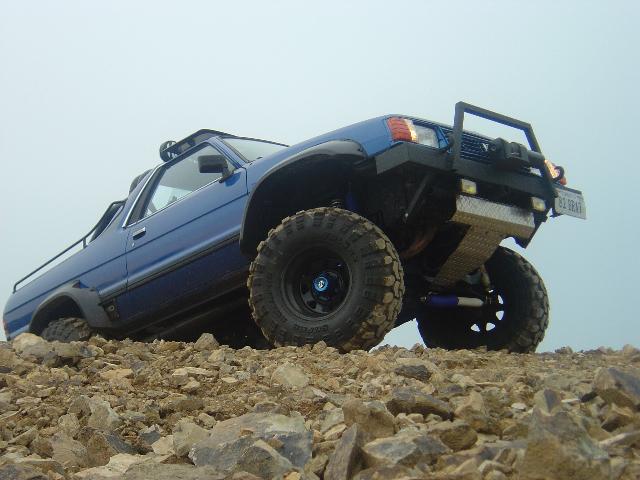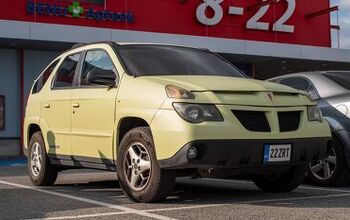New or Used?: Bratty About Perceived 4WD Needs
Gregory writes:
So… if ”utes” work so well in Australia, why not North America?
In the NorAm market, we have the Subaru BRAT (1978–1987), Volkswagen Caddy (1980-1996?), Dodge Rampage/Plymouth Scamp (1982-1984), Ford Ranchero (1957-1979), Chevrolet El Camino (1959-1987) and then the Subaru Baja (2003-2006).
To be honest, I’m considering buying a Subaru Baja Turbo. I need a 4-wheeled vehicle for two quite specific needs: 1.) household utilitarian trips, to places like Ikea or Home Depot, to carry the lawn mower to grandma’s, to haul garbage to the dump or to carry fire wood; 2.) road trips with the girlfriend, carrying her bags & bicycle around, long country road drives where we can listen to loud music, hear audio books, shift gears through the twisties, and have audible conversation.
I commute & grocery shop by bicycle or motorcycle, so definitely do not need a 4-wheeled vehicle for those chores. I think a Subaru Baja (or perhaps the new Hyundai i30/ Elantra Touring) would fit. Perhaps a four-door pick-up truck? Other station wagon? Old Land Cruiser?
Sajeev Answers:
I still don’t understand why Utes went out of style. Perhaps they never were “in” style, and the ever-increasing popularity of “real” trucks made producing a car-based truck more challenging. And since CUVs are here to stay, no amount of Camino/Chero talk on yesteryear’s Jalopnik by the great Davey G. Johnson can bring it back.
Just a guess, now onto your query.
Subaru Baja? Even if you have complete faith in the previous owner’s oil change regiment, certain years of Subies from that era are unreliable, statistically speaking. They are so hit-or-miss I can’t possibly recommend them, not to mention even the reliable ones “enjoy” high labor rates because of their remarkable engine packaging. Plus, with AWD (and a premium-swilling Turbo?) they aren’t exactly fuel sippers: a small motor Chevy Avalanche, Ford Sport Trac or Honda Ridgeline do the same but need less attention. Which makes a bit more sense to me. But not really, it’s all overkill for your needs.
So you are firmly set in CUV territory. The durable design of the Honda Element seemingly checks all the boxes, but perhaps the blocky styling (and its impact on highway fuel economy) and interior design shall put you off. Then go more car like, Toyota RAV4, Honda CR-V, Chevy Equinox, Hyundai Santa Fe and Ford Escape are proven entry-level choices for your needs. Want more decadence? Go a little bigger: Highlander, Pilot, Edge, etc: I think you see where I am going with this. And while going mainstream with CUVs is off putting for many, they are the platform of choice for automakers: they get the most R&D dollars for everything from in-car entertainment to powertrain refinements. So do yourself a solid and get the most up-to-speed vehicle for you need. Enjoy the numerous test drives in your future.
Steve Answers:
Let’s break down what you just mentioned. You need a 4-wheel drive vehicle because…
1) household utilitarian trips, to places like Ikea or Home Depot, to carry the lawn mower to grandma’s, to haul garbage to the dump or to carry fire wood: this can be done with any number of vehicles. Pickups of all sizes. SUV’s and wagons that have rear windows that go down. Even a conventional car with a light trailer would do the trick. Four-wheel drive is not a true need unless you’re climbing Mount Olympus.
2.) road trips with the girlfriend, carrying her bags & bicycle around, long country road drives where we can listen to loud music, hear audio books, shift gears through the twisties, and have audible conversation: and any car can be given a bike rack and 5-speed vehicles come in all shapes and sizes.
You are more or less trying to spend $10k+ on a problem that can be solved for less than $1k. If you like your current drive and it can tow at least 2000 pounds, just buy a $500 utility trailer from Craigslist with a few tie-downs. From there get a bike rack for your vehicle. That’s it. No need to waste more time or money.
But if you must have another vehicle I’d work backwards. Find sellers who have taken great care in maintaining their car, and keep an open mind. I happen to prefer more compact vehicles that provide plenty of fun for the road ahead… and there are a near infinite variety out there with a handshaker. Buy what makes you happy. Or better yet, be like me and invest the money in shipping stocks and Vanguard emerging market funds.
Need help with a car buying conundrum? Email your particulars to mehta@ttac.com, and let TTAC’s collective wisdom make the decision easier… or possibly much, much harder.
More by Sajeev Mehta and Steve Lang
Latest Car Reviews
Read moreLatest Product Reviews
Read moreRecent Comments
- El scotto UH, more parking and a building that was designed for CAT 5 cable at the new place?
- Ajla Maybe drag radials? 🤔
- FreedMike Apparently this car, which doesn't comply to U.S. regs, is in Nogales, Mexico. What could possibly go wrong with this transaction?
- El scotto Under NAFTA II or the USMCA basically the US and Canada do all the designing, planning, and high tech work and high skilled work. Mexico does all the medium-skilled work.Your favorite vehicle that has an Assembled in Mexico label may actually cross the border several times. High tech stuff is installed in the US, medium tech stuff gets done in Mexico, then the vehicle goes back across the border for more high tech stuff the back to Mexico for some nuts n bolts stuff.All of the vehicle manufacturers pass parts and vehicles between factories and countries. It's thought out, it's planned, it's coordinated and they all do it.Northern Mexico consists of a few big towns controlled by a few families. Those families already have deals with Texan and American companies that can truck their products back and forth over the border. The Chinese are the last to show up at the party. They're getting the worst land, the worst factories, and the worst employees. All the good stuff and people have been taken care of in the above paragraph.Lastly, the Chinese will have to make their parts in Mexico or the US or Canada. If not, they have to pay tariffs. High tariffs. It's all for one and one for all under the USMCA.Now evil El Scotto is thinking of the fusion of Chinese and Mexican cuisine and some darn good beer.
- FreedMike I care SO deeply!

































Comments
Join the conversation
This divide between the contributors and the commentariat on Subarus is surprising. I'm going to side with the commentariat, though - I'm on my second Subaru (a 2008 Outback NA, the first was a '95 Legacy Outback with the 2.2) and they've been extraordinarily reliable. The '95 finally went away this year after 130K miles, mostly hard-driven city driving, with a dying fuel pump and a valve tick, both totally acceptable faults on a 16-year-old car. No head gasket issues. Collectively my family has owned 5 Subarus over the years and they've been uniformly the best vehicles we've had - the interiors wear hard, they're mechanically bulletproof if maintained, they're an absolute pleasure to drive (particularly in comparison to CUVs), and the winter-weather capability is magnificent. I've never needed to put snow tires on through winters in Idaho, Montana and Chicago. Just after buying the 2008 Outback this summer I had the experience of driving a 2010 RAV4 in Alaska, which I think everyone would agree is a pretty comparable vehicle - a 2.4L inline-4, lockable diff, capacious. It was dead obvious to me which was the better car, though - the RAV4 had no additional ground clearance and yet managed to feel like a top-heavy SUV despite Toyota's best efforts. (I also put no stock in the whole "commanding driving position" argument; the Subaru is already taller than it needs to be.) So for all that, the Subaru is the ideal vehicle as an all-rounder, with one main caveat, which is the fuel economy penalty for the weight and friction loss of the AWD system. The gas mileage does, in fact, suck for a car its size. However, given that the poster motorcycles or bikes for lots of his mileage, that drawback is quickly offset, and even more so if most of the car's mileage would be highway. The Honda, Toyota, Hyundai, and Ford CUVs are all comparable in terms of space and AWD capability, but they are just blander, lamer vehicles - undistinguishable engines, poor driving dynamics compared to real cars, and the same cultural implications that station wagons used to have. What's really sad is that Subaru has given in to the same stupid CUV thinking and turned the Outback into just another contender in that market. All I can do is hope that they'll see the error of their ways by the time I need a new wagon.
Thank you Sajeev & Steve for your advice. Also, thank you to all the wonderful commentators who had significant advice and comments. It truly _is_ the commentators that make this site what it is. Reading their posts, I always feel like I'm in a bar having an intensely important, hand-waving conversation about... well, about cars. I like the idea of utes. A mid-2000s Baja Turbo will probably do, or a V70 R in a stretch. The Mazda 5 is very, very interesting. It's a Hyundai Elantra Touring/ i30, but with character. Death to all Cam-ccords! I would also go for the Pinzgauer. Nice suggestion! That's my inner-Boy Scout speaking. But I don't think Girlfriend would be willing to ride around in it. Something about being girly. Geesh. -gregory ps. For what it's worth, my first car, in Vancouver, BC, in the early 1990s, was a beige Citroen 2CV. Two cylinders rock! Then I owned an Asia Rocsta (diesel, of course), in Korea, in the late-1990s/ early-2000s. Now I own a Kawasaki KLR 650 in Portland, OR. So... -GCE